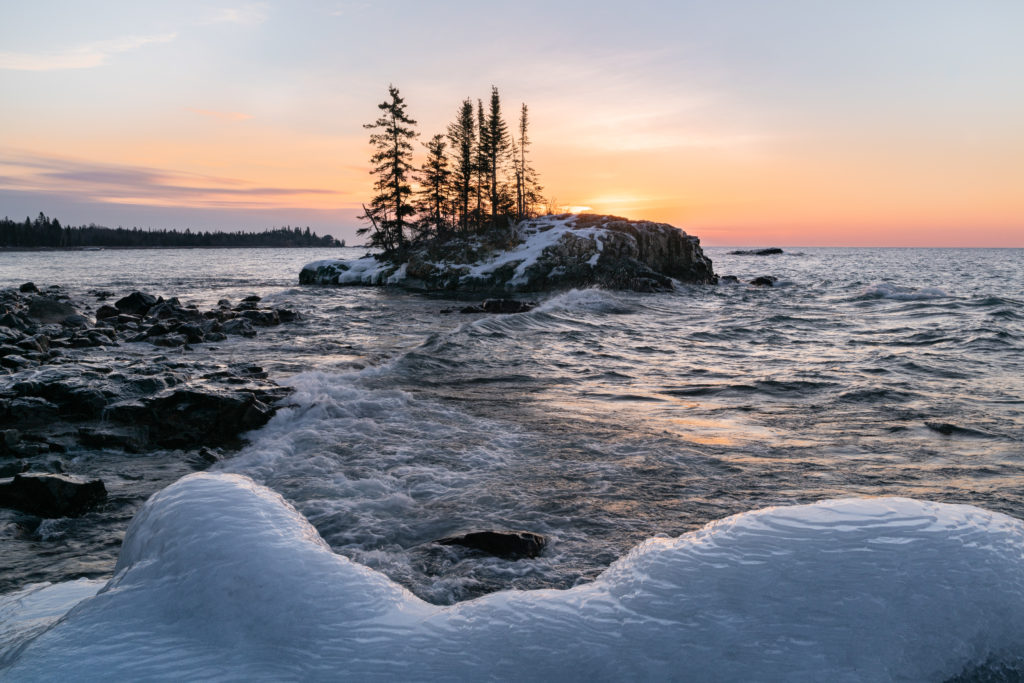Winter Wonderland on the SHT
November 28, 2022

Winter on the Superior Hiking Trail is a wonderland.
The deep green of the spruce and pine contrasts against the pure white of the snow and piercing blue of winter skies.
After a fresh snowfall, a deep silence falls over the forest unlike any other time of the year.
The snow makes a perfect canvas for the tracks of all the Northwoods critters along the trail. From tiny shrew tracks to moose tracks, winter reveals the woods may be quiet but they are full of life.
With some additional preparation and safety practices, spending time on the SHT during winter can offer some of the best treks of the year.
Alert: Heavy snows, ice, and wind have created difficult Trail conditions
As of Jan. 11, 2023, many sections have downed trees and snow-bowed brush leaning into the Trail. Combined with deep snow – up to 3 feet on certain sections – the Trail may be difficult to navigate and follow safely. For more information, click to read the Duluth News Tribune’s recent article.
It is still possible to use the Trail, and a lovely time out in the woods, but we are recommended you plan shorter hikes and give yourself additional time to complete them. Snowshoes are recommended for all users to help with navigating around downed trees and brush.
Stay safe out there and remember if you do lose the Trail, one of the best things you can do is stop, turn around, and follow your own tracks in the snow until you find the Trail again or back to your starting point.
Check our Trail Conditions page for information about specific sections for additional alerts. Our Trail Conditions page also includes a list of plowed trailheads.
Tips for a safe and fun winter hike or snowshoe
- The safety risks can be higher in winter. Cold weather and snowy or icy trail conditions make it even more important to practice the first step of Leave No Trace — Plan ahead and Prepare — so that you can safely and responsibly enjoy the SHT. Make sure someone knows your trip plan and when you plan to return.
- Bring your Ten Essentials. Bring items for navigation, insulation, illumination, nutrition, hydration, emergency shelter, sun protection, first-aid, making fire, and a repair kit. Click here to read more about what the National Park Service’s list of the ten essential items for safe hiking.
- Set achievable goals. Even when the Trail is packed down well (thanks, snowshoers!), winter travel can be much slower and days are much shorter in the winter. Plan short trips until you know your pace and be sure to bring all the essentials in case something goes wrong. Check our Trail Conditions prior to setting out.
- All trail rules still apply in the winter. Please stay on the Trail, leash and clean up after your pets, pack out what you pack in, camp only at designated campsites, and be respectful to fellow trail users. Latrines may be hidden under feet of snow. Deep snow and frozen ground also prevent digging cat holes. Please be prepared to pack out your waste.
- Dress for the weather. Dontcha know it gets real cold up here in northern Minnesota — especially when the wind picks up. The Trail’s proximity to Lake Superior means weather conditions can change quickly and intensely. Check the forecast and wear and pack multiple layers so you can stay warm and comfortable in variable conditions. Pro tip: Leave dry, warm clothes in the car to change into after your hike. Second pro tip: Try to stay as dry as you can while you’re hiking. If you start to sweat, remove a layer. Staying dry means staying warm in winter.
- Stay hydrated. We don’t experience thirst the same way in winter. Make sure you remember to keep drinking water during winter treks. Bringing a hot drink in a thermos can also be a great treat for break time. Water can freeze quickly depending on the temperature when stored in uninsulated containers on the outside of your back. Water freezes from the top down (where it comes into contact with the air bubble in your bottle), so one trick commonly used by winter trekkers is to flip water bottles upside down so the opening remains free of ice longer. Double-check the top is screwed on tight before you flip!
- Bring lots of calories. Our body works twice as hard to keep us warm during the winter. Fuel both for your trek and to help your body stay warm. If you start feeling too cold on your hike, try drinking water, changing into a dry layer, and eating a snack.
- Wear snowshoes or stay on well-packed trail to avoid postholing. Postholing occurs in deep, wet snow when hikers without snowshoes sink into the snow, creating a hole. When the snow freezes later, these holes can create a hazard for hikers coming behind you, who can trip or turn an ankle in the frozen posthole. Snowshoeing is a great way to navigate fresh snow and pack down the Trail for others. Be on the lookout for ice too — traction devices for your boots like microspikes will help with grip. Please stay off groomed ski trails. Cross-country skiers have a short season for their sport, so please respect their trails by staying off the groomed track where the SHT shares access with a ski trail. Walk to the side until you access a non-shared stretch of Trail.
- Use caution near frozen water. Snow cover can hide holes in the ice. Please use caution when hiking near or on bodies of water during the winter. Click here to listen one SHT community member’s harrowing experience about falling through the ice on Cascade River two miles from help.
- Don’t rely on digital devices. As helpful as digital maps and apps can be, cold weather drains phone and GPS batteries quickly. Always carry good ol’ reliable paper maps and guides. You can find our guidebooks and maps for the Trail in our online store. Insulating batteries from the cold also helps preserve battery power. Tuck your phone, gps devices and any battery-powered lights into an inside pocket to keep them warm and charged.
- Stick to likely-plowed trailheads. A list of likely-plowed trailheads will be posted on the Trail Conditions page soon. (You can also find plowed trailheads in the SHT Databook.) State and city park trailheads tend to be the most quickly and consistently plowed, but know that conditions change rapidly.
- Protect the Trail by staying off of muddy tread and trailheads. At the beginning and end of the winter trail season, the freeze/thaw cycle can leave the tread of the SHT and many of our trailheads muddy and more susceptible to damage. Be mindful of your impact.
The silence, solitude, and stunning leaf-off views found on the SHT during the winter make it worth taking some extra steps to enjoy Winter Wonderland on the Trail.

